Pork is the culinary name for meat from the domestic pig (Sus domesticus). It is one of the most consumed meats worldwide, with evidence of pigs being raised for eating, dating back to 5000 BC. Pork is eaten both freshly cooked and preserved. In the United States, the U.S. Department of Agriculture recommends cooking ground pork, that is obtained from pig carcasses, to an internal temperature of 160 °F, followed by a 3-minute rest, and cooking whole cuts to a minimum internal temperature of 145 °F, also followed by a 3-minute rest.
Pulled pork, USA

American barbecue way (from the western part of North Carolina) of cooking pork meat slowly over low heat. Tender meat can easily be pulled of the bones and shredded into small pieces. Generally, pork shoulder piece is used, which is marinated with a vinegar, pepper, and tomato sauce. Nowadays, pulled pork is popular throughout the world and is mostly used in a variety of sandwiches, accompanied by fries, baked beans, and tangy sauces.
Feijolada, Brazil
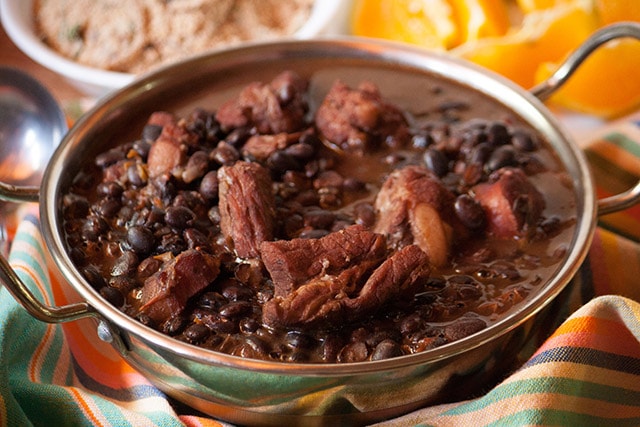
Brazil’s national dish, where every family in Brazil has their own, special recipe. Feijoada or feijoada completa, a hearty stew featuring pork and black beans. The beans are flavored with onions, tomatoes, coriander, and garlic, while pork meat can be additionally enriched with dried beef and smoked pork sausages. Sautéed greens, cheese rolls, rice, and fresh, sliced oranges are served as an accompaniment to the smoked pork and richly flavored black beans.
Porchetta, Italy

Porchetta is a traditional, and festive Italian dish prepared all over Italy. This rustic dish is made by carefully deboning a piglet or a fully grown pig, flavoring it generously with salt, garlic, rosemary, fennel seeds or some other aromatic herbs and filling it with the stuffing (liver, fat or pieces of skin and meat, also flavored with salt and spices). The meat is then rolled up, and slowly roasted over a wood fire. When finished, it is sliced very thinly and served warm or cold with some bread.
Carnitas, Mexico
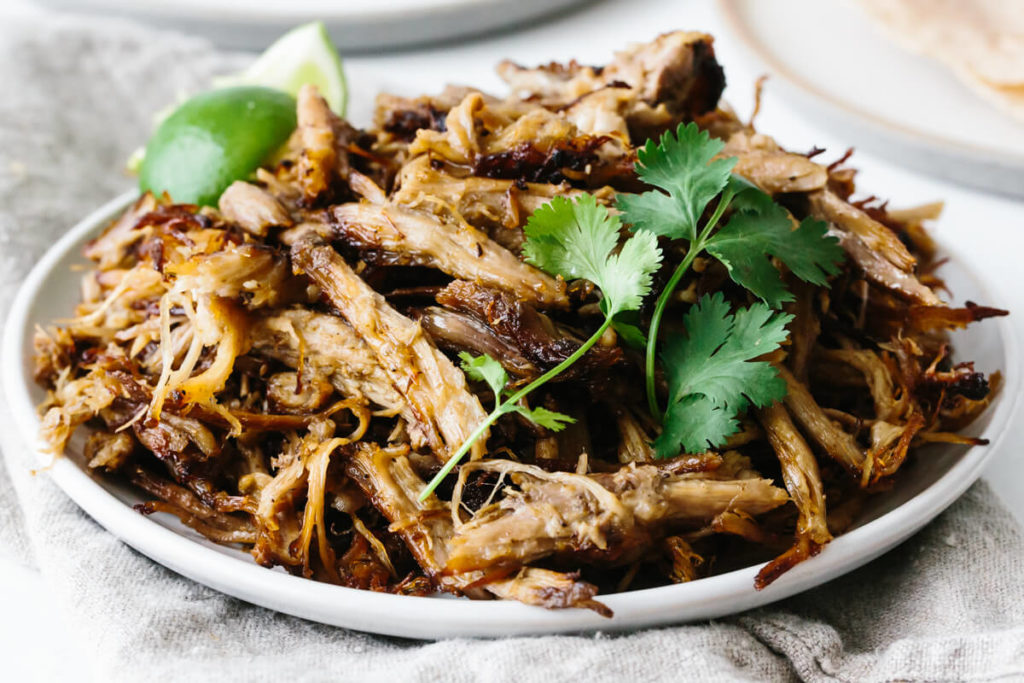
Mexican flavorful dish. Made from pork (typically front sections or pork shoulder) that is braised, roasted, or slow cooked in its own fat for a long time until fully tender and juicy. The meat is shredded (pulled out of the bones), is often served with tortillas, accompanied by salsas, beans, guacamole, lime, or fresh vegetables.
Pernil, Puerto Rico, USA

Puerto Rico’s most famous dish. Juicy roasted pork shoulder that is traditionally seasoned in a marinade called adobo mojado (made of paprika, salt, vinegar, garlic, and oregano). Pork shoulder, which is more economical cut, and is more available has become a key ingredient in Pernil. The dish is a staple at numerous Puerto Rican festivities such as birthdays or weddings, where many people feast on the crunchy skin and tender meat that falls off the bone.
Cochinillo, Spain

Spanish dish involving whole roasted suckling pig with succulent meat, tender and crispy skin, and a very thin layer of fat. The meat is so tender that it practically falls apart when cooked properly. The pigs should not be heavier than five kilograms nor older than three weeks, and they are traditionally roasted in large, open-faced brick ovens. One suckling pig can easily feed a party of four, and it is usually ordered in restaurants for birthdays and similar festive events.
Golonka, Poland

Pork hock, or pork knuckle, is usually seared and slowly cooked until tender. It is usually served whole, on the bone, alongside boiled potatoes, cabbage, a variety of cooked vegetables, and horseradish or mustard sauce. It has become an integral part of Polish cuisine, with many distinctive regional variations such as honey and beer glazed (Golonka w piwie).
Schweinbraten, Germany
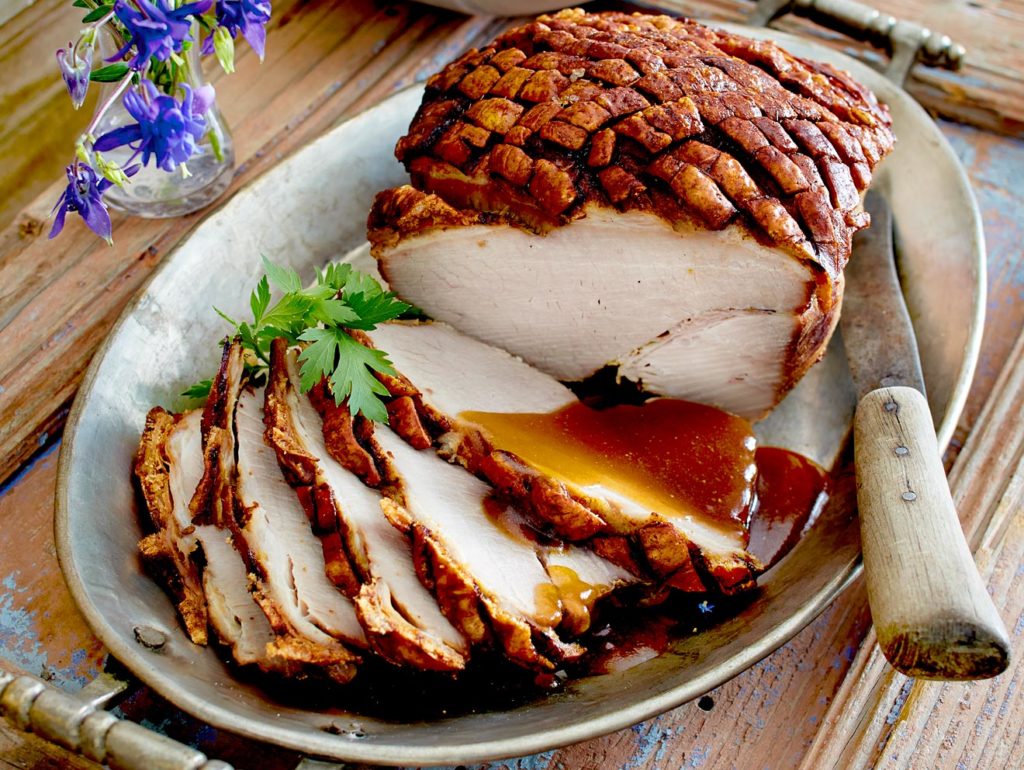
traditional German pork roast. boneless pork shoulder. Before the preparation, pork is often rubbed with mustard, marjoram, or minced garlic, giving it a bit of extra flavor. It is sliced pork roast that is served with homemade gravy, Semmelknödel (bread dumplings) or potato dumplings (see dumplings post!), and either sauerkraut or rotkohl (red cabbage).
Spam, USA

Canned meat mixture, that become one of the Americans staples. Square-shaped mixture of pork, water, salt, sugar, potato starch, and sodium nitrate called Spam sold more than eight billion cans since the product was made available in 1937. The product’s popularity and sales skyrocketed after World War II when it was sent abroad to satisfy the hunger of American soldiers, its indefinite shelf life making it possible to be shipped all over the world without spoiling. Nowadays, used simple as a bread topping for sandwiches, or used as an ingredient in more elaborated recipes.
Kotlet schabowy, Poland

Polish Breaded Pork Cutlet, variation of the famous Wiener schnitzel. One of the most popular Polish dishes. It is typically prepared with a thin breaded pork chop or tenderloin, fried in lard, and served alongside cooked potatoes, sauerkraut, and various fresh and pickled salads.
Nóżki w galarecie, Poland

Polish specialty, particularly in the holiday season. Pig hogs and knuckles, cooked for a long time, until all the gelatinous goodness is released. The meat is peeled of the bones. The portions of meat, together with few pieces of carrots and onions (cooked together), is placed in small round dish, preferably a bowl. Then the jelly broh is poured over, and left in the fridge overnight, to set. Next day, they are ready to eat! Served upside down, out of the bowl, in half round shape. Always sprinkled with white vinegar, to cut the fat, and with fresh rye bread and some pickles.
Gua Bao, Taiwan

Taiwanese braised pork belly bun. Soft steamed buns filled with tender pieces of pork belly. Braised in aromatic sauce (soy sauce and red wine with five-spice powder). Served with addition of sour pickled mustard greens, chopped cilantro, and a sprinkle of lightly sweetened peanut powder.
Fritada, Ecuador
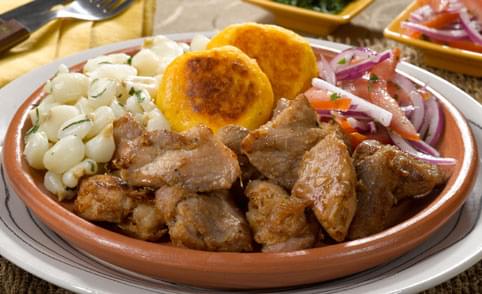
Traditional Ecuadorian dish. Diced pork boiled down in water and left to fry in its own drippings. Pork is generously seasoned, while onions and garlic are usually cooked alongside the meat. Depending on the region, potatoes, plantains, hominy, fava beans, or corn can be served as side dishes accompanying tender and juicy chunks of pork.
Menudo Filipino, Philippines
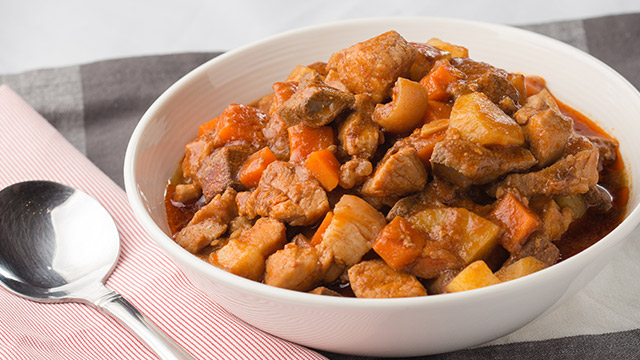
Comfort food stew, that can be found in abundant regional varieties Chopped marinated pork, carrots, potatoes, and pork’s liver, raisins, bell peppers, garbanzo beans, and red-hot dog sausages, with a creamy tomato sauce. Menudo is typically prepared for every important event in the Philippines and comes with steamed rice served on the side.
Melton Mowbray Pork Pie, UK

world-famous Melton Mowbray pork pie is one of the British jewels. Filled with the finest fresh pork meat (chopped and seasoned with salt and pepper). Melton Mowbray pies are traditionally baked free-standing, without a form, which gives the golden-brown pastry case its typical shape.
Butadon, Japan

Japanese comfort dish. Bowl of rice that is topped with sliced fatty pork cooked in a slightly sweet soy sauce. Comes topped with additional garnishes of green peas and onions.
Karbonāde, Latvia

beloved dish in Latvia, that is a version of Wiener schnitzel. Thinly hammered pork cutlet that is coated in flour, beaten eggs, and breadcrumbs before it is fried to perfection. A savory chanterelle mushroom sauce is usually spooned over the finished pork schnitzel before serving, while sides such as boiled potatoes with dill, French fries, cabbage salad, pickled vegetables, and slices of rye bread often accompany the whole dish.
Smothered Pork Chops, USA
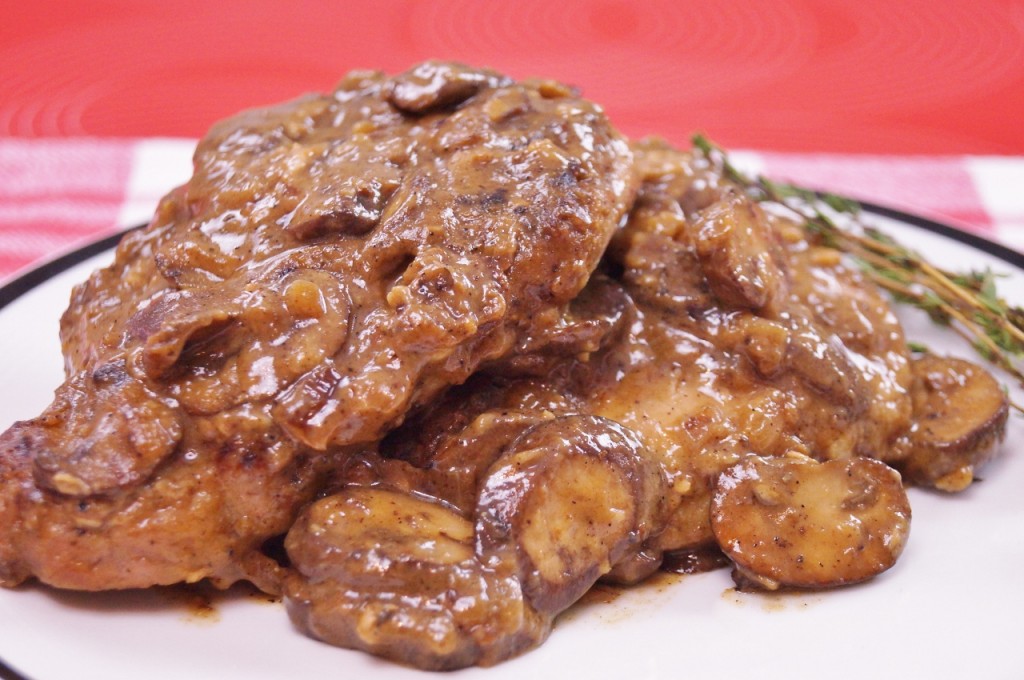
traditional dish from Louisiana, where there are many recipes simultaneously, of the same dish. Generally made with pork chops, onions, celery, bell peppers, garlic, flour, water, and Creole seasoning. The pork chops are fried (often in bacon grease), smothered in gravy, then served, either as a dish, or accompanied by rice, field peas, or smothered potatoes.
ST. Louis style ribs, USA
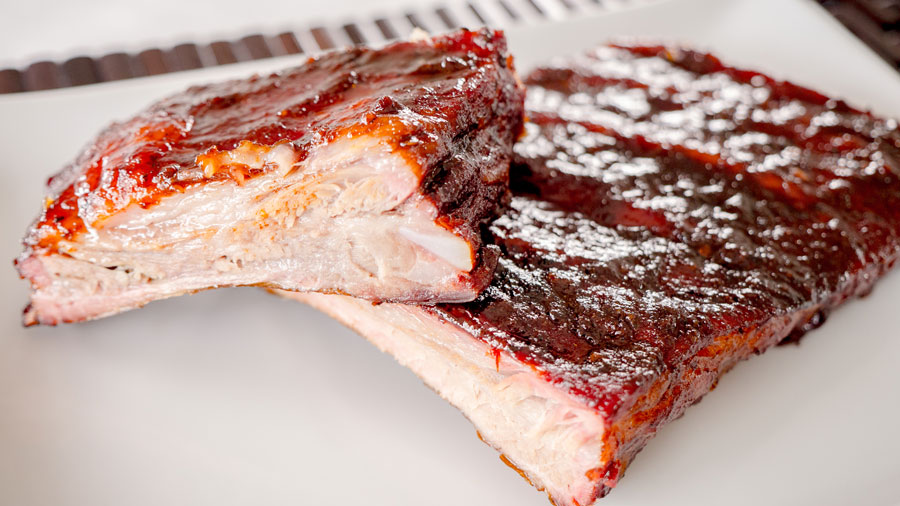
St. Louis-style ribs are pork spareribs, that has got its name from the cut (squaring the rib slab by sawing off the tips) rather than the cooking method. Before being placed on the grill, the meat is typically seasoned with salt or rubbed with selected spices, and it is then brushed with barbecue sauce which should be sticky, sweet, and slightly acidic, usually based on tomatoes. St. louis’ ribs are the meatier ribs cut from the belly (after the pork belly is removed). The ribs are flatter than baby back ribs, which makes them easier to brown. There is a lot of bone but also a higher amount of fat, making them very flavorful.
Schab faszerowany, Poland
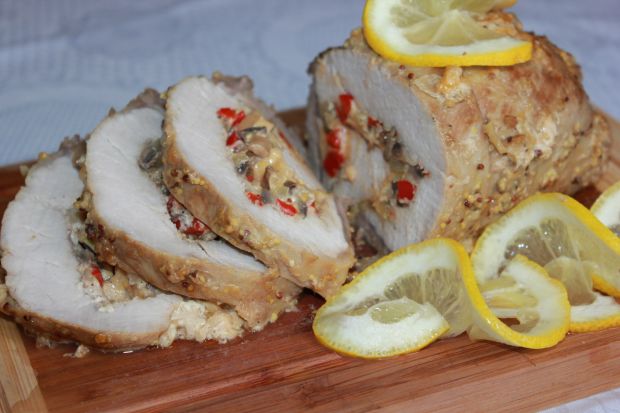
This traditional Polish Sunday dinner dish. Lean, uncured pork loin stuffed with ground pork or sausage and typically, either prunes or dried apricots. The loin is then rolled, rubbed with a rich blend of herbs, and roasted until golden brown. Served with boiled potatoes sprinkled with dill, and a side salad.
Mørbradbøffer i flødesovs, Denmark

This Danish classic. Pork tenderloin paired with large amounts of onions, all covered in a creamy sauce. Traditionally baked as a casserole and, completed with mushrooms or crispy bacon bits. It is typically served alongside potatoes, rice, and pickles.
Afelia, Cyprus

Popular dish Cypriot and Greek dish. In fact, fairy simple in preparation. Cubed pork meat (shoulder or short rib), dry red wine (to tenderize the meat), and crushed coriander seeds. Afelia is bursting with a fragrant combination of sweet and sour flavors, and it is usually served with accompaniments such as crusty bread, potatoes, or pourgouri (pilaf made with vermicelli, bulgur wheat, and chicken broth). It can also be served over plain rice and drizzled with leftover baking juices.
Fun Fact* coriander is a cornerstone spice in Cyprus, and it is rare to find a true traditional Cypriot dish without it).
Lechon, Philippines

one of the most popular dishes in the Philippines – roasted suckling pig. The suckling pig is normally stuffed with lemongrass, tamarind, garlic, onions, and chives, and is then roasted on a large bamboo spit over an open fire. Lechon is often served with a thick and rich liver sauce that is cooked with sugar, fresh herbs, and vinegar. It is traditionally served whole on a platter, at celebrations and festive events. Once the meat is properly roasted and falls off the bone, people tend to eat every part of the pig, and the crispy, reddish-brown, crackling skin is especially beloved.
Vindaloo, Goa, India

flavorful curry dish, popular in England and the Indian regions of Goa and Konkan. The Portuguese explorers brought the dish to Goa in the 15th century. The Name come from the mispronounced Portuguese dish called carne de vinha d’alhos, meaning meat marinated in wine vinegar and garlic. Typically made with marinated pork. The Many Indian spices were incorporated into the dish, such as tamarind, cinnamon, cardamom, and hot chiles.
Bacon and cabbage, Ireland

Irish dish that is traditionally made on St. Patrick’s Day. Easy and cheap to make. Bacon in the dish refers to cured pork joint from the shoulder, paired with cabbage, and sometimes potatoes, onions, carrots, or turnips. The dish is often accompanied by a white sauce (butter, flour, milk, and fresh parsley).
Griot, Haiti
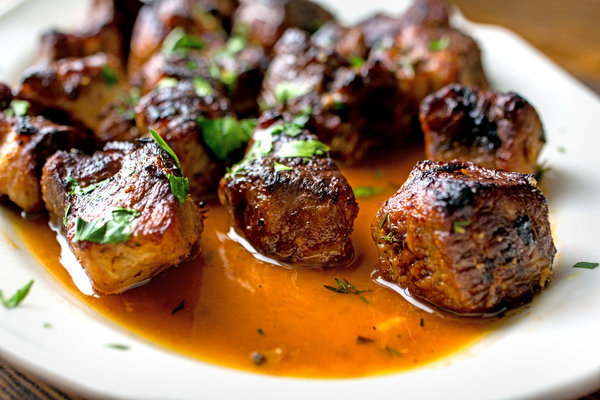
considered Haiti’s national dish. Pork meat chunks slowly cooked in a sweet, spicy, and tangy marinade of chile peppers, onions, orange, lime, or lemon juice until tender, then fried pan fried. the dish is also special for its flavors – heat from the chiles, the sweet and sour acidity of citrus juices, the richness of meat, and the unique, browned exterior. The sauce acts as a cooking liquid, typically reduced to a shiny glaze. As pork meat was scarce and expensive in Haiti, the dish was made only for special occasions and festive events.
Pomana porcului, Romania
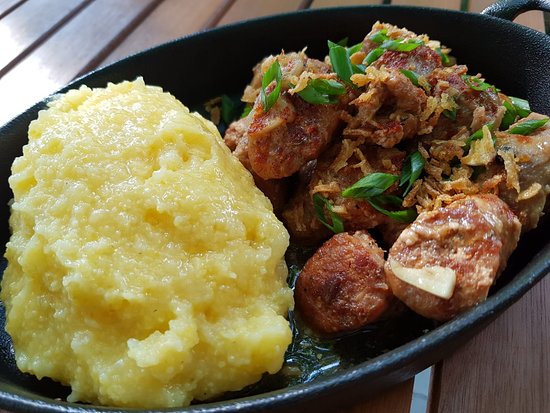
Different cuts of pork: ribs, tenderloin, and liver, different types of sausages (modern variation of the recipe). The ingredients are basically fried in lard, and the dish is usually served with mămăligă (type of cornmeal porridge like polenta). Pomana porcului is usually associated with the traditional pig slaughter, just before Christmas. The meal is prepared by families as a sign of appreciation for everyone who had helped them in the process.
Šunka u kruhu, Croatia

festive Croatian delicacy. Whole smoked and cooked ham, wrapped in dough, made of flour, yeast, lukewarm water, lard, and salt. The ham is traditionally flavored with bay leaves, garlic, and ground pepper. Baked in an oven. It must be left to cool down before serving. Šunka u kruhu is usually prepared for Easter, but it can also be made throughout the year as a hearty main dish.
Hackepeter (Mett), Germany

German specialty spread, popularized in 1970s. Raw, minced pork seasoned with basic salt and pepper. Sometimes enhanced with crushed caraway, marjoram, nutmeg, garlic, or onions for additional flavor. There are plenty of different types, of this dish. Zwiebelmett (with raw onions), thüringer Mett (onions and marjoram), Schinkenmett (ham Mett; the upper thigh (ham), ground especially fine). It is also sold in the form of mettwurst, a spicy, raw sausage, often smoked. In Germany, seasoned raw pork mince is typically enjoyed spread over bread rolls (mettbrötchen) or slices of bread, usually sprinkled with raw onion rings on top.
Kotlet mielony, Poland

The Polish version of popular breaded meat patties consists of ground pork, soaked bread, eggs, and a variety of spices and fresh herbs. Usually shaped into flattened round or oval shapes, the patties are pan-fried until they are dark brown and crispy on the outside. They are traditionally served alongside boiled or mashed potatoes and fresh or pickled salads.
Kassler, Germany
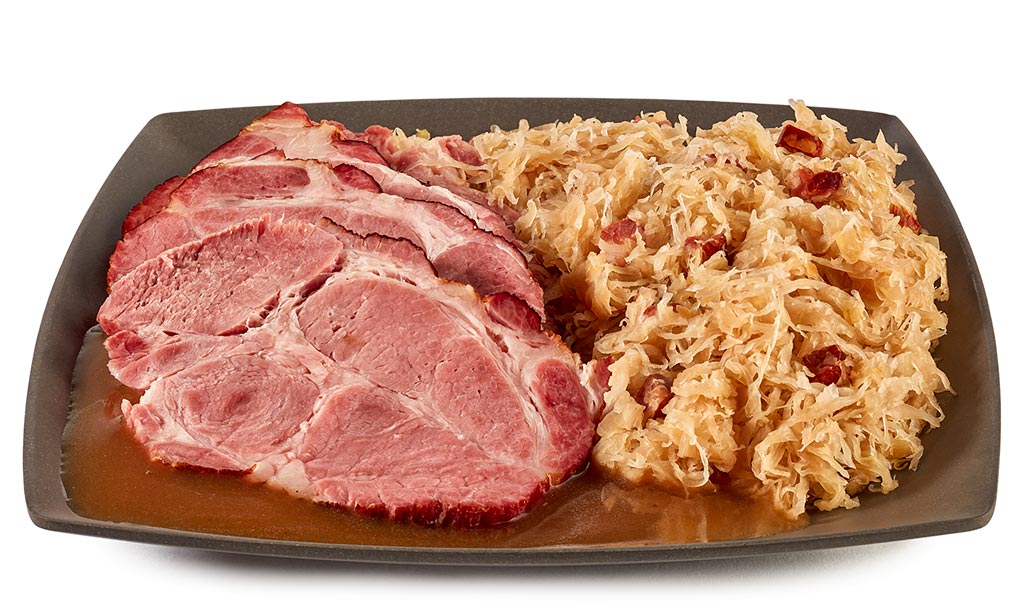
traditional Oktoberfest dish. Salted (cured) and slightly smoked cut of pork like British gammon (hind leg of pork after it has been cured by dry-salting or brining). It can be either hot or cold smoked. Pork necks and loins are the most often used cuts although ribs, shoulders and bellies can also be used. When served, pork is almost always accompanied by sauerkraut and mashed or boiled potatoes on the side.
Carne de porco à Alentejana, Portugal

Wine infused chunks of pork with clams and a lightly spicy, wine-infused sauce. Marinated for some time in white wine, paprika, red pepper paste, chopped garlic, coriander, bay leaf, salt, and white pepper. In northern Portugal, cumin is added as well. It is fried until golden brown when clams are added and cooked. Traditionally, this dish is served with cubed potato fries or baked potatoes. It is usually garnished with fresh cilantro and paired with lemon wedges, and country-style bread on the side.
Jokbal, South Korea
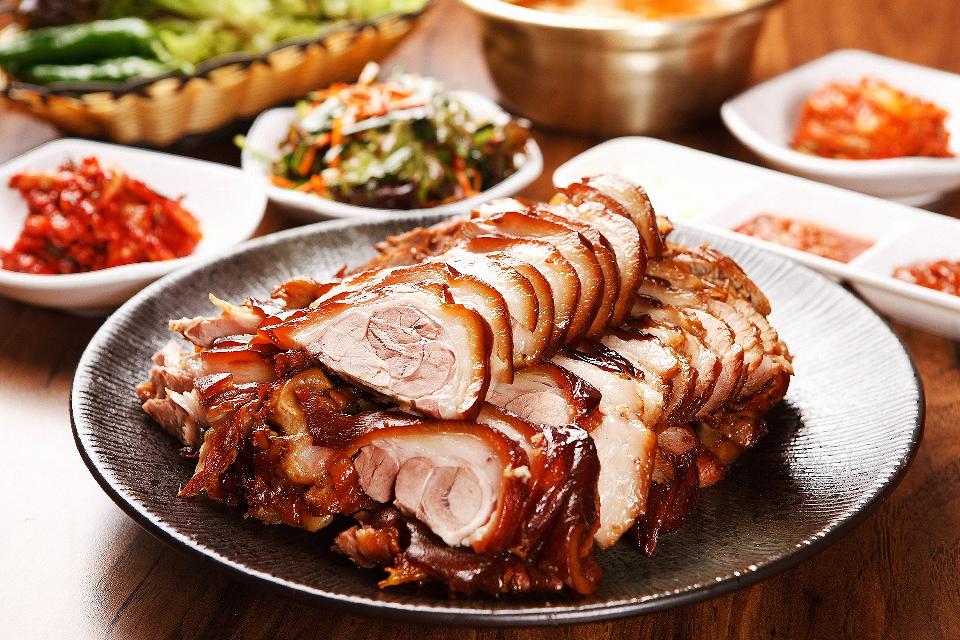
popular South Korean dish. Boneless and steamed pig’s legs. The meat is usually marinated with a combination of soy sauce, ginger, and black taffy, giving the dish a unique flavor. Jokbal is traditionally served with kimchi and shredded radish, while the condiment of choice is usually ssamjang (blend of fermented bean paste and pepper). It is recommended to serve Jokbal wrapped in lettuce leaves.
Char siu, China
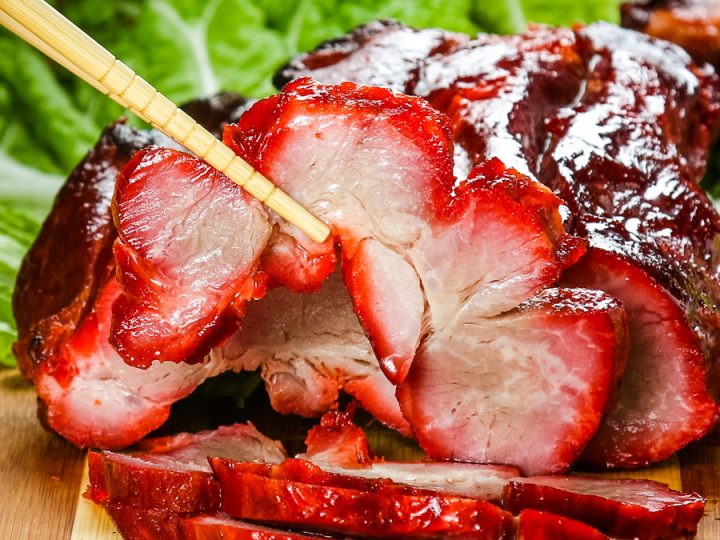
Fork Roasted Meat Chinese BBQ Pork Siu mei. Roasted, barbecued pork that has previously been marinated in aromatic sauce (soy sauce, hoisin sauce, rice wine, and star anise). Meat is placed on an extended fork and roasted over an open fire that caramelizes the sugars found in the marinade. The pork is usually served either as a sliced appetizer or shredded and chopped as a main meal.



